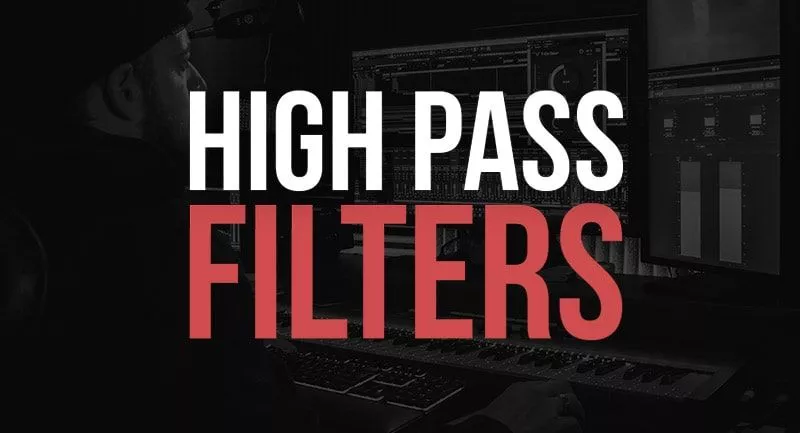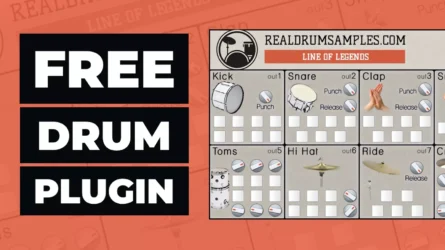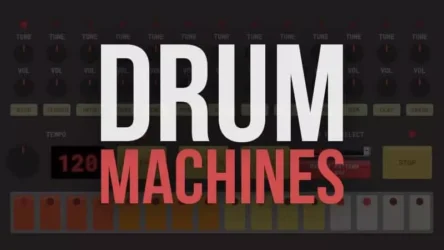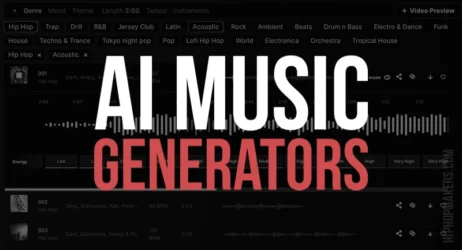This guide will answer what is a high pass filter in audio, what high pass filters are used for, and how to use high-pass filters properly.
What Is A High Pass Filter In Audio?
High Pass Filter (HPF) is an electronic filter that allows frequencies above the cutoff frequency to pass and attenuates frequencies below the cutoff frequency. It is very often used in mixing and mastering for improving the quality of a recording.
- What Is A High Pass Filter
- What Is A High Pass Filter Used For
- High Pass Filter vs. Low Pass Filter
- How Do You Use A High Pass Filter
- When To Use A High Pass Filter
- Why Use The High Pass Filter On Your Mic
- High Pass Filters & Vocals
- Why Is It Called A High Pass Filter
What Is A High Pass Filter?
A high-pass filter is an audio filter that passes frequencies above its cutoff frequency and attenuates frequencies below the cutoff frequency.
Low Frequencies that aren’t necessary and add unnecessary noise. The high pass filter can be used on almost any audio source, but it is most commonly used on vocals.
Many high-end mixing boards come with HPFs that can be very useful for cleaning up an audio track – allowing you to remove unwanted noise and get a cleaner sound.

Related: 50 Best Free Filter VST Plugins
What Is The Importance Of HPFs?
High Pass Filters are key in producing a clean and dynamic-sounding vocal track. A high pass filter is used to remove the low-end (bass) of a signal. Low frequencies add noise and can interfere with other instruments in the mix.
You can use a high pass filter on vocals to remove all the unnecessary low-end sounds that are not needed to be heard. This will provide a much cleaner and, at the same time, crispier sound.
Who Uses High Pass Filters?
High pass filters are often used in recording studios for improving the quality of a recording. For example, high-pass filters can improve sound clarity by leaving out unnecessary low-end frequencies.
Most musicians use high pass filters while recording to reduce the bass in a track. For example, if you are only going to use the higher frequencies of a guitar in a recording, there is no need to have the low-end frequencies cluttering up the mix.
High pass filters are also often used in DJing to reduce the low-end frequencies that are unnecessary when playing back recorded music.
Which Music Genres Use HPFs?
Many music genres benefit from high pass filters. High-pass filtering is especially useful in genres like Pop, Rock, Rap, and Electronic music.
However, high pass filters are not limited to only these genres. High-pass filtering is helpful for any genre requiring a clear and balanced sound, especially jazz and classical.
Tips For Using High Pass Filters
Below are some tips for using HPFs:
- Check your nearby frequencies to ensure you don’t cut off needed frequencies or remove too much of the low end.
- Increase saturation with the drive knob to accent the higher frequencies and punch them more.
- If you’re using Ableton Live, use an HPF with an LFO to create movement in the cutoff frequency.
- If you are cutting low frequencies, consider parallel compression to keep some of the bass elements while cleaning up the high end.
- Consider using a hi-pass filter before distortion or an exciter to avoid muddiness if you are boosting frequencies.
What Is A High Pass Filter Used For?
High pass filters can be used for a variety of purposes, such as:
1. Removing Low-end Frequencies
High pass filters can be used to remove low-end frequencies from a track – allowing you to reduce the noise and unwanted sounds. The HPF will cut off frequencies below the cutoff frequency, making a track sound cleaner and more focused.
2. Removing Vocal Cords And Sibilance
High pass filters can remove the low-end and low-mid frequencies from vocals and open up a track. Cutting out these frequencies will bring clarity to the vocals and give them space. This is especially useful for reducing sibilance, creating a smoother vocal track, and removing vocal cords.
3. Enhancing High Frequencies
High pass filters can enhance high frequencies on tracks that lack brightness and sparkle. The HPF will remove any unwanted low-end and mid-range frequencies – leaving only the high-end open to create a brighter track.
Related: Best Audio Mixing Courses Online
Which Is Better, High Pass Filter Or Low Pass Filter?
Both the high pass and low pass filters are used in audio equipment to perform many tasks. While both filters do similar things, they are better used for different purposes.
Low pass filters are better used to “cut” frequencies. Low pass filters will allow all frequencies below the cutoff to pass and filter out those above it.
High Pass Filter (HPF) is used to “boost” frequencies by removing unwanted frequencies. High pass filters will only allow the desired frequencies above the cutoff to pass.
How Do You Use A High Pass Filter?
To use a high pass filter, insert it onto the track you are using it. From there, use the cutoff knob to set the frequency you want to turn into a high-pass filter.
From there, use the resonance and drive knobs to control the filter and change its behavior. Use the Q knob to adjust the resonance while focus adjusts the bandwidth.
Finally, use the mix knob to balance the filtered and the original track.
Once your high pass filter is set up, use the volume knob to control how much of the filter you hear in the track.
The technique is not easy, and it will take practice to get it right. But once you have a handle on how to use a high pass filter, you can begin cleaning up your tracks and make them sound their best.
When To Use A High Pass Filter?
High pass filters can be used in almost any situation and on nearly every track. Whether you are cleaning up the low-end frequencies or enhancing the high-end, an HPF can be used for a variety of tasks.
In general, high pass filters should be used whenever you want to clean up your tracks and remove unwanted noise. For example, a high pass filter can reduce sibilance and eliminate unwanted mouth sounds when you are recording.
Why Use The High Pass Filter On Your Mic?
Many people use a high pass filter on a microphone to cut out the low-end and mid-range frequencies. It can be easy for mouth sounds to show up in your recordings, especially when speaking close to the mic.
An HPF might not be necessary for all situations, but it will help clean up your recordings. You can use high pass filters on any needed track, including vocals, instruments, and more. High pass filters will open up tracks and make them sound bigger and cleaner.
High pass filters are extremely useful, but they need to be used carefully not to create problems for your recordings. Some of these instances include:
- Removing too much low-end or mid-range frequencies.
- Over-boosting noise and causing clipping in the track.
- Creating a boxy sound when used on vocals.
If you use high pass filters properly, however, they can be very helpful in cleaning up and adding a room to your tracks.
Once you discover how high pass filters work and what they can do – it is easy to see why they are used in some form on nearly every track.
Related: What Is Clipping In Audio
What Does A High Pass Filter Do To Vocals?
A high pass filter allows frequencies above the cutoff to pass while filtering out frequencies below. By using an HPF on your vocals, you essentially remove low-end sounds and leave only the high-end for a brighter tone.
The result is often much cleaner vocals still present in the track without sounding too harsh or brittle. While a high-pass filter is a great option for cleaning up vocals, it can be used with other tracks as well – including instruments and any track that needs more clarity.
Why Is It Called A High Pass Filter?
High pass filters got their name because they allow all frequencies above the cutoff to pass and filter out any below it. High pass filters are the opposite of low pass filters, allowing frequencies below the cutoff point to pass.
Since high pass filters allow to pass only high frequencies, they are called high pass filters. In music, high pass filters are used to clean up tracks and make them sound bigger or enhance any track’s high-end.
Summary of High Pass Filters
A High Pass Filter or HPF allows frequencies above a cutoff frequency to pass and attenuates those below. It is very often used in mixing and mastering to improve the quality of recordings.
I hope you now have a good understanding of high pass filters and how to use them.




